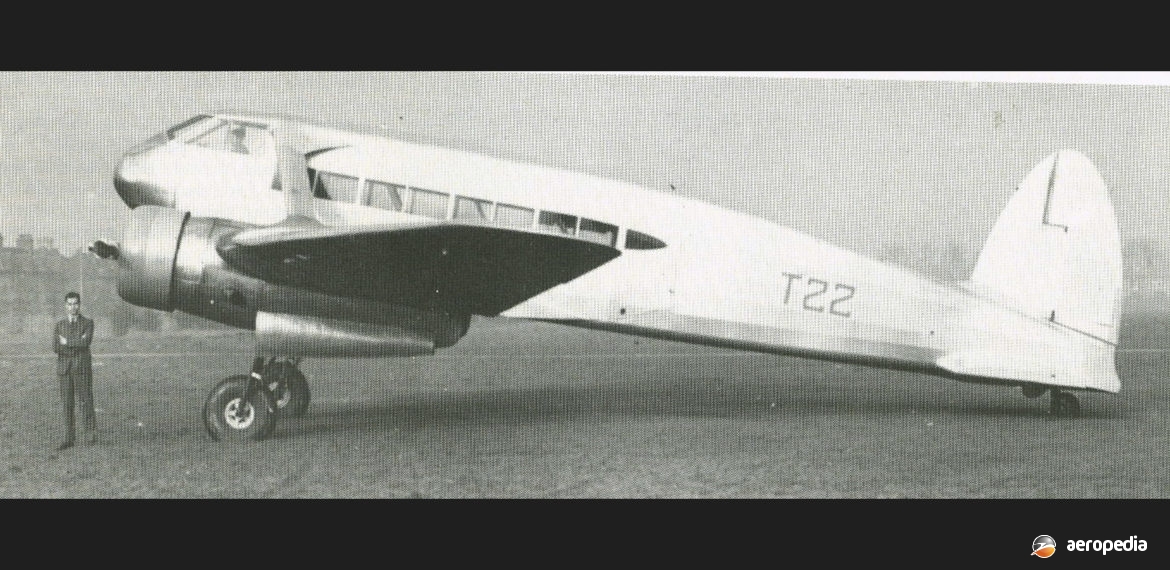Photograph:
General Aircraft ST.18 Monospar Croydon G-AECB (c/n GAL/ST/18/501) at Hanworth in Middlesex, United Kingdom in 1936 (A J Jackson collection)
Country of origin:
United Kingdom
Description:
Commercial airliner
Power Plant:
Two 336 kw (450 hp) Pratt & Whitney SB-9 Wasp Junior nine-cylinder air-cooled radial engines
Specifications:
- Wingspan: 18.13 m (59 ft 6 in)
- Length: 13.19 m (43 ft 3 in)
- Cruising speed: 306 km/h (190 mph)
- Landing speed flaps down: 101 km/h (63 mph)
- Service ceiling: 5,913 m (19,400 ft)
- Single engine ceiling: 2,286 m (7,500 ft)
- Max rate of climb at 1,524 m (5,000 ft): 335 m/min (1,100 ft/min)
- Cruising range at 65% power at 3,962 m (13,000 ft): 1,448 km (900 miles)
- Empty weight: 3,629 kg (8,000 lb)
- Loaded weight: 5,148 kg (11,350 lb)
History:
General Aircraft in 1934 appointed David Hollis Williams as chief engineer and in that year the Company moved to Hanworth in Middlesex, United Kingdom where Williams commenced design of the ST.18, a ten-seat, twin-engine, low-wing airliner with a cruising speed of 306 km/h (190 mph) and a range in excess of 966 km (600 miles).
The prototype G-AECB (c/n 501 – ex T-22) was built at Hanworth during 1935, the tentative price to a purchaser being $16,000 (£8,000). Oceanic Airways of Australia had shown interest in the aircraft, this company having been involved in the operation of a number of General Aircraft Monospars.
The protoype was ready for flight testing in March 1936 and was shown to British Airways but that airline preferred the American-built Lockheed 14. Major C R Anson of Anson Airways indicated an intention to buy the type if the prototype completed a record flight to Australia.
In order to prove the aircraft, with Lord Sempill as the designated pilot, with Mr H Wood as the second pilot, and two other crew members consisting of Mr Gillroy as wireless operator, and Mr Davies as ground engineer, plans were made to fly the aircraft to Australia. Only modification to the aircraft was the installation of two extra fuel tanks, which increased the fuel available by 182 litres (40 Imp gals). The intention was to operate at normal weights and not exceed the normal maximum cruising speed in order to simulate normal airline operation.
The aircraft left Croydon in Greater London on 30 July 1936 and flew to Melbourne, VIC, in a total flying time of 76 hrs 43 mins for the 20,128 km (12,507 miles) at an average speed of 262 km/h (163 mph). Stops were made at outback centres in Queensland, including Cloncurry.
After a demonstration tour, the aircraft left Melbourne on 6 October 1936 in an attempt to set a new record for the Melbourne to London flight, stopping at Darwin, NT on the first night. Early on 7 October it left Darwin on the second leg of the journey to Koepang in Indonesia. The weather was fine and there was a following wind. However, the aircraft ran short of fuel, landing on Seringapatam Reef, nearly 483 km (300 miles) off course during a flight of 966 km (600 miles).
The crew was rescued by a British ship, the ‘SS Nimoda’. The aircraft could not be flown from the reef and stayed in situ. Although not seriously damaged, it was covered to a depth of one metre by the sea at high tide, and a week later to a depth of 4.2 metres (14 ft). Salvage was not possible and the machine eventually decayed. An inquiry revealed the aircraft was flying with compass problems and the crew was relying too heavily on D/F bearings, whereas the crew blamed Darwin control for the mishap. Only the one example of the Croydon was built.

